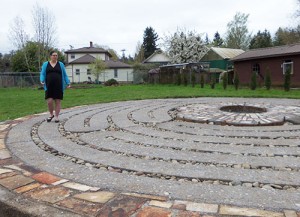
By Melissa Wagoner
Walking a labyrinth is a personal experience.
“The journey to the center is the journey to the center of the person’s soul,” said Sister Jeanine Tisot, the director of the Shalom Prayer Center in Mount Angel.
People who walk the labyrinth often find peace because it is a spiritual tool for focusing one’s energy, to be silent, to pray, to seek union with God.
The Shalom Prayer Center hosts two labyrinths, a canvas one inside the prayer center purchased in 2007, and one outdoors built in 2012. A third labyrinth was recently completed in Silverton.
As a gift to the community and opened in April, the stone labyrinth at St. Edward’s Episcopal Church is another place of peace and contemplation for use by community members.
“We hope that the labyrinth can be a gift from our congregation, past, present and future, to the community of Silverton, and the world at large,” said The Rev. Shana McCauley of St. Edward’s.
The sixth annual World Labyrinth Day is Saturday, May 3. The Labyrinth Society invites people to “Walk as One at 1” in the afternoon, to “join others around the globe to create a wave of peaceful energy washing across the time zones.”
What is a Labyrinth?
A labyrinth is a single
path or unicursal tool for
personal, psychological and
spiritual transformation.
Labyrinths are thought to
enhance right brain activity.
St. Edward’s Episcopal Church
211 W. Center St.,
Silverton.
503-873-6188
The labyrinth is in the
style of Chartres Cathedral
in Chartres, France. It is
open to the community as a
place of meditation and prayer.
Shalom Prayer Center,
a ministry of Queen of Angels
Monastery
840 S. Main St., Mt. Angel.
503-845-6773
There are two labyrinths:
One outside and one inside
the Shalom Prayer Center, open
8 a.m. to 4 p.m.
Monday through Saturday.
All faiths are welcome at
all three labyrinths.
The St. Edward’s labyrinth has been in the works for eight to 10 years and was funded by gifts from the parish, mostly in memorial. It has been a labor of love with contributions of time and work by many members of the church, including Laura Antonson, a landscape architect who created the design, and Tim Beck, a mason who created the intricate concrete forms and poured the paths.
Antonson has had extensive labyrinth experience.
“The first time I saw one was in high school. It was printed on a canvas and rolled out in a gym,” Antonson said. “I’ve seen labyrinths made out of any and everything.”
Labyrinths have been found all over the world dating from the earliest antiquity. Their origins are lost in the mists of time, according to the Labyrinth Society’s website.
In her research, McCauley has found labyrinths in almost every religion including the Jewish tradition of Kabbala, the Hopi Medicine Wheel and sand paintings done by Tibetan Buddhists.
At the Shalom Center, a ministry of the Queens of Angels Monastery, the labyrinths are used almost every day.
“We have had retreats here at Shalom whose total focus is using the labyrinth as a meditation practice,” Tisot said.
All three labyrinths are based on the 800-year-old “Chartres” pattern, a rose with six petals surrounded by 11 paths.
According to the Labyrinth Society’s website, the labyrinth was a central feature in many of the European Roman Catholic churches in the middle ages with many of the labyrinths still in existance today.
The most famous of these is at Chartres Cathedral near Paris, France. The labyrinth was built around 1200. It was walked as a pilgrimage or for repentance.
As a pilgrimage, it was a journey to become closer to God.
When used for repentance, the pilgrims would walk on their knees. Sometimes this 11-circuit labyrinth would serve as a substitute for an actual pilgrimage to Jerusalem. The cross is at the center of the pattern of the labyrinth and is used in the construction as a guide. Even today, churches with labyrinths encourage the faithful to walk the labyrinth during Lent and Advent.
“The Chartres design, when walked, seems to lead in an illogical pattern, bringing the participant close and then far and then close again to the center, until the person ends up in the middle,” McCauley said.
“Many of us experience our relationship with God this way – at times nearer, at times farther, even as we long to be close to the Divine Spirit,” McCauley said.
She said many people experience a journey om the labyrinth in three stages: Purgation, the release of daily concerns, Illumination, a time of meditation and prayer and Union, the journey outward accompanied by a sense of peace.
“Unlike mazes, where there are many paths, most of which lead to dead ends, a labyrinth has one continuous path toward the center,” McCauley said.
“There is no wrong way to walk a labyrinth, you can’t make a mistake.”